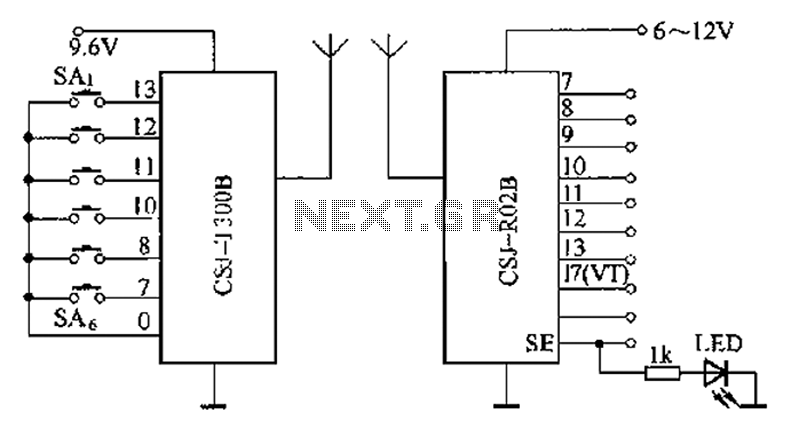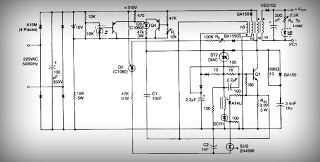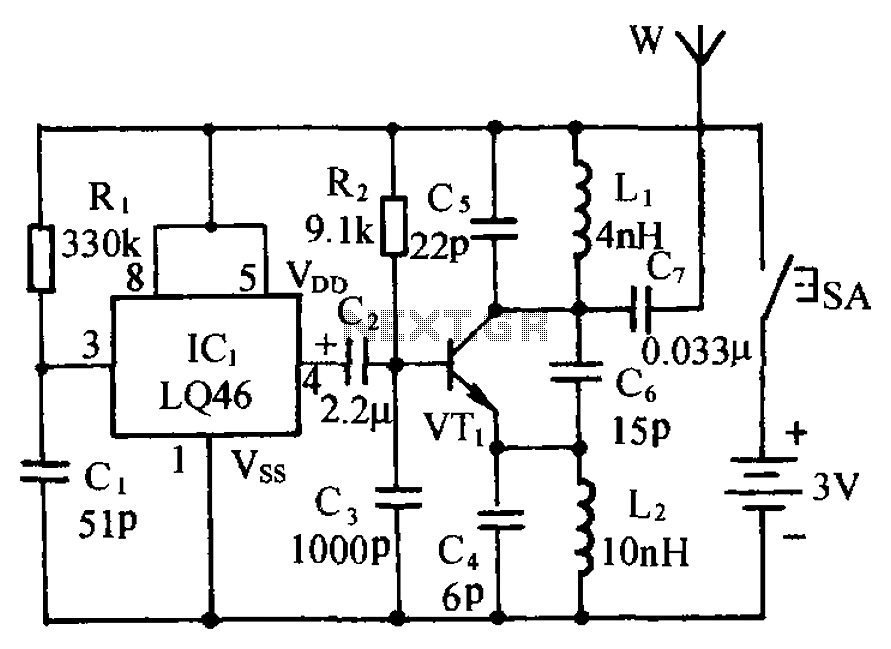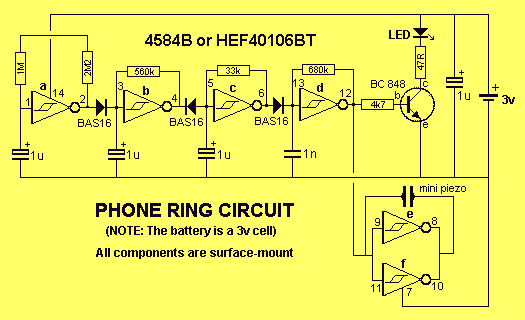
fm wireless hi fi schematic
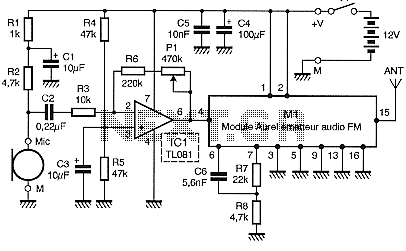
To alleviate any concerns related to high frequency, a ready-made Aurel audio FM transmitter module has been utilized. This compact circuit board, measuring 2 cm by 4 cm, supports a modulation frequency track and delivers an RF power of 10 mW, which is adequate for the intended application. Driven by a surface wave resonator, the module exhibits excellent frequency stability. The schematic review indicates that the module can operate independently for certain high-frequency applications, as it does not require additional power and includes a pre-emphasis network composed of resistors R7, R8 and capacitor C6, designed to enhance the quality of higher frequency transmissions. The circuit requires an input level of 100 mV RMS to achieve an adequate modulation rate, necessitating a preamplifier for the microphone. This function is fulfilled by IC1, configured as a standard inverting amplifier with adjustable gain via potentiometer P1. The included microphone is an electric model with a power supply circuit formed by resistors R1, R2, and capacitor C1; however, a conventional dynamic microphone or an external electric microphone with an integrated power supply can also be used, in which case R1, R2, and C1 would be omitted. The transmitter employs an Aurel module, serving as an FM audio receiver, which is also a compact circuit board containing all necessary components for the receiver, equipped with a squelch circuit for effective operation. The audio output is available at pin 10 of the module and should be decoupled through capacitor C4 to mitigate the effects of the pre-emphasis circuit used in the transmission. The audio frequency level output from the module may be insufficient for certain high-fidelity amplifiers or mixers, typically reaching only 100 mV at best; thus, amplification is performed by IC1, a conventional preamplifier. This preamplifier is powered continuously by the Aurel module, receiving its power from pin 18 of the module. This output is controlled by the internal noise circuit, which activates the power when valid audio signals are detected. The operating threshold of the squelch is adjustable, managed by potentiometer P2, which serves as the sole external control for the receiver. The power supply must be regulated to 5 volts, achieved through IC2, which can accept input voltages ranging from 9 to 15 volts from a suitable amplifier or a wall adapter. The low power consumption of the entire setup, approximately 30 mA, facilitates this power supply design.
The Aurel audio FM transmitter module is designed for applications requiring reliable audio transmission over radio frequencies. The compact size and built-in features of the module make it suitable for various projects, including portable audio systems and wireless microphone setups. The pre-emphasis network enhances transmission quality by compensating for high-frequency losses, ensuring clearer audio output. The adjustable gain of the inverting amplifier allows for customization based on the microphone sensitivity, providing flexibility in different environments and applications. The squelch circuit integrated into the receiver module is particularly advantageous for reducing noise during periods of silence, enhancing the listening experience. The power management aspect, with its low consumption and adjustable input voltage range, ensures compatibility with a wide range of power sources, making this circuit versatile for both hobbyist and professional use. Overall, this circuit represents a well-engineered solution for high-quality audio broadcasting in a compact form factor.To relieve you of any concern related to high frequency, I used a module ready, in case a module Aurel audio FM transmitter. This tiny circuit board with 2 cm by 4 cm supports a transmitter modulation frequency track, delivering an RF power of 10 mW which is quite sufficient for the desired use.
As it is driven by a resonator surface wave, its fre quency stability is excellent. As you can see the review of the scheme, the module can stand alone even for some HF itself since it lacks power and a network of pre-emphasis R7, R8, C6, designed to improve quality transmission of higher frequencies. The input level required by the circuit to achieve a sufficient modulation rate of 100 mV rms, a preamplifier is necessary for our microphone.
It is the role of IC1, mounted on a very classic inverting amplifier with adjustable gain through P1. The provided microphone is a model electric with its supply circuit formed by R1, R2 and C1, but you might as well use a conventional dynamic mic, or an external electric microphone with its integrated power supply in which case R1, R2 and C1 disappear.
As to the transmitter, I used a module Aurel, which is an FM audio receiver. It also appears as a tiny circuit board containing all the components of the receiver, equipped with a squelch circuit or quiet as I put to good use. As illustrated, the audio output takes place on the leg 10 of the module and should be dG©saccentuG©e through capacitor C4 to offset the effect of pre-emphasis circuit used in the show.
The AF level issued by the module may be insufficient for some high fidelity amplifiers or mixers certain: it is only 100 mV in the best cases I amplifies a bit through rose IC1 very classic. This preamplifier is fed continuously as the module Aurel but instead receives its power through the leg 18 of the latter.
This output is in fact controlled by the internal circuit noise and is connected to power when the circuit noise estimates have detected a valid issue. The operating threshold of the muffler is adjustable and is obviously the role of the potentiometer P2 is the only external control of the receiver.
The food in turn must be regulated to 5 volts, which is made by IC2 which can receive input from 9 to 15 volts from such amplifier associated with a block or sector-style outlet. The low power consumption of the arrangement (of the order of 30 mA) makes this power supply. 🔗 External reference
The Aurel audio FM transmitter module is designed for applications requiring reliable audio transmission over radio frequencies. The compact size and built-in features of the module make it suitable for various projects, including portable audio systems and wireless microphone setups. The pre-emphasis network enhances transmission quality by compensating for high-frequency losses, ensuring clearer audio output. The adjustable gain of the inverting amplifier allows for customization based on the microphone sensitivity, providing flexibility in different environments and applications. The squelch circuit integrated into the receiver module is particularly advantageous for reducing noise during periods of silence, enhancing the listening experience. The power management aspect, with its low consumption and adjustable input voltage range, ensures compatibility with a wide range of power sources, making this circuit versatile for both hobbyist and professional use. Overall, this circuit represents a well-engineered solution for high-quality audio broadcasting in a compact form factor.To relieve you of any concern related to high frequency, I used a module ready, in case a module Aurel audio FM transmitter. This tiny circuit board with 2 cm by 4 cm supports a transmitter modulation frequency track, delivering an RF power of 10 mW which is quite sufficient for the desired use.
As it is driven by a resonator surface wave, its fre quency stability is excellent. As you can see the review of the scheme, the module can stand alone even for some HF itself since it lacks power and a network of pre-emphasis R7, R8, C6, designed to improve quality transmission of higher frequencies. The input level required by the circuit to achieve a sufficient modulation rate of 100 mV rms, a preamplifier is necessary for our microphone.
It is the role of IC1, mounted on a very classic inverting amplifier with adjustable gain through P1. The provided microphone is a model electric with its supply circuit formed by R1, R2 and C1, but you might as well use a conventional dynamic mic, or an external electric microphone with its integrated power supply in which case R1, R2 and C1 disappear.
As to the transmitter, I used a module Aurel, which is an FM audio receiver. It also appears as a tiny circuit board containing all the components of the receiver, equipped with a squelch circuit or quiet as I put to good use. As illustrated, the audio output takes place on the leg 10 of the module and should be dG©saccentuG©e through capacitor C4 to offset the effect of pre-emphasis circuit used in the show.
The AF level issued by the module may be insufficient for some high fidelity amplifiers or mixers certain: it is only 100 mV in the best cases I amplifies a bit through rose IC1 very classic. This preamplifier is fed continuously as the module Aurel but instead receives its power through the leg 18 of the latter.
This output is in fact controlled by the internal circuit noise and is connected to power when the circuit noise estimates have detected a valid issue. The operating threshold of the muffler is adjustable and is obviously the role of the potentiometer P2 is the only external control of the receiver.
The food in turn must be regulated to 5 volts, which is made by IC2 which can receive input from 9 to 15 volts from such amplifier associated with a block or sector-style outlet. The low power consumption of the arrangement (of the order of 30 mA) makes this power supply. 🔗 External reference
